Constellation of the southern sky, in our latitudes only its northern part rises above the horizon. The constellation is only beginning to be clearly visible from the southern regions of the Mediterranean. The Wolf lies on the northeastern edge of the southern Milky Way between Scorpius and Centaurus, below Libra. Its pattern is made up of several 2nd and 3rd magnitude stars, most of which belong to the vast Scorpio-Centaurus stellar association. Many of them are binaries, as can be seen in a small telescope: ε, κ (3.9mag, 5.8mag, 26.8"), μ, η (3.6mag, 7.6mag, 15") π (4 , 6mag, 4.7mag, 1.4") and ξ Lupi (5.3mag, 5.8mag, 10.4"). Like other constellations in the Milky Way, the Wolf harbors several open clusters, the brightest of which is the large NGC 5822, visible even to the binocular near ζ Lupi. We also find a few planetary nebulae, globular clusters and galaxies.
In a constellation that is all adorned with the rich structure of the Milky Way near its center, there is a very remarkable dark nebula called Barnard 228. This thin but up to four degrees long dust belt can be found near the stars ψ1 and ψ2 Lupi. It looks like a narrow dark channel in the stellar field and is best seen in wide fields of large binaries that enhance the contrast between the dark nebulae and the surrounding Milky Way. Finding it in the field of view is not difficult, just move the telescope slowly eastward from the stars of ψ Lupi.
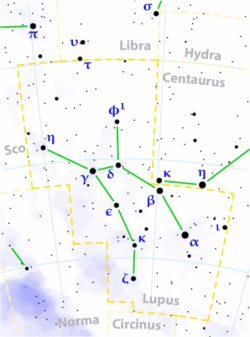
α Lup - The brightest star of the constellation. It varies in apparent magnitude from 2.3mag to 2.8mag in a period of 0.260 days. It has a faint companion with a magnitude of 13.4mag. It is located 460 light-years away.
η Lup - The triple star system, whose main component has a blue-white color and the companion has a dark blue color. The difference in their brightness is quite significant (3.6 mag and 7.8 mag), but with their separation of 15", we should be able to distinguish them even with a small telescope. The second companion, with a magnitude of 9.4, is located 115" away from the main component. Just to the northeast, there are two pairs of white stars, each 20" wide.
κ Lup - A nice double star, whose white components with magnitudes of 3.9 and 5.8 have a separation of 26.8", so a telescope with a 5 cm objective is sufficient for their resolution. It is only an optical double star.
μ Lup - A triple star system, whose main two white components have a magnitude of 5.1mag and 5.2mag. They are located in close proximity of 1.2" and are a good test for a 100 mm telescope. The brighter component also has a yellow companion of magnitude 7.3mag, which is located at a distance of 23.7" and is visible even in a smaller telescope.
π Lup - A nice system of almost equally bright pale blue stars, which however requires a relatively large magnification to be able to distinguish it. The stars are only 1.4" apart. Their magnitudes are 4.6 and 4.7. They are located at a distance of 440 light years.
ξ Lup - Clear, relatively wide pair (10.4"), easily distinguishable in small telescopes. The components have magnitudes of 5.3 and 5.8, with observers perceiving their colors differently: some see them as light yellow, while others say that one has a white and the other a greenish tint. Generally, stars with an AO spectrum appear white to pale blue.
SN 1006 - In the constellation, the brightest recorded supernova in human history erupted in the past. It was noticed by the inhabitants of China and Japan, as well as the Middle East and Europe. When it first appeared in the sky in the spring of 1006, it was about as bright as Mars in opposition. However, within a few weeks, it easily surpassed Venus and brightened to -7.5 magnitude, equivalent to the brightness of the Moon in the first quarter. The supernova remained visible for the next two years, and even briefly during the day. Today, we only observe a cloud of debris from the ancient stellar explosion at this location.
Herschel 4788 - A binary star, which is a good test for a 100-150 mm telescope. During a calm night, this unequally bright pair of white and yellow stars appears as two disks in contact. However, if there is any turbulence in the atmosphere, the stars merge into one elongated droplet. They are separated by 2.2" and their magnitudes are 4.7mag and 6.7mag, respectively.
NGC 5822
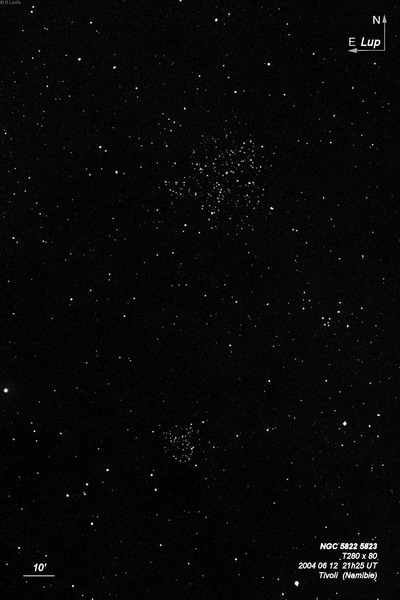
John Herschel discovered NGC 5822 = h3588 on 3 Jul 1836 and recorded "cluster, vL, coarse, but rich and fine; diam in RA = 2 field in PD 25 (30' and 45'); stars 9, 10, 11, 12. General middle taken." His position, though, is on the east side of the cluster. Megastar's position (following NGC 5823) is erroneous.
It seems surprising that James Dunlop (and Nicolas-Louis de Lacaille) missed this bright cluster. But perhaps he didn't. Glen Cozens reported a list of copying errors that Dunlop made between his notes and his published catalog. In the case of Dunlop 357, he reported an RA of 14h 15m, but his handwritten notes show the RA is 14h 50m (for 1827). This corrected RA lands on the west side of NGC 5822 and his description fits very well: "a very extensive cluster stars of mixed small magnitudes; the stars appear to be either congregating together in different parts of the cluster, or breaking up; there are several groups already formed, the whole cluster is composed of lines of stars, but no general attraction towards any particular point."
200/250mm - 8" (7/13/91 - Southern Baja): roughly 60 stars mag 9-12 resolved at 63x. Very large, 40' diameter, almost fills the low power field, elongated ~NW-SE. Spread out with no central condensation. Many stars have similar magnitudes. The stars forming the borders are arranged in rows and arcs with many empty gaps inside this outline. There is an extension of stars to the south.
400/500mm - 18" (7/10/05 - Magellan Observatory, Australia): excellent open cluster at 76x (27 Panoptic). Appears very large, fairly rich, with the main body extended ~WNW-ESE and with dimensions ~40'x25' with roughly 150 stars resolved. The stars are fairly uniform in brightness (many mag 11 and 12) and convincingly arranged in loops and chains surrounded by voids. The outline is quite irregular but well defined by the star chains around the periphery. One chain detaches from the main group near the center and heads south and the outline tapers at the following end. Easy in 10x30 IS binoculars, 7° NE of Alpha Centauri.
Notes by Steve Gottlieb
NGC 5986
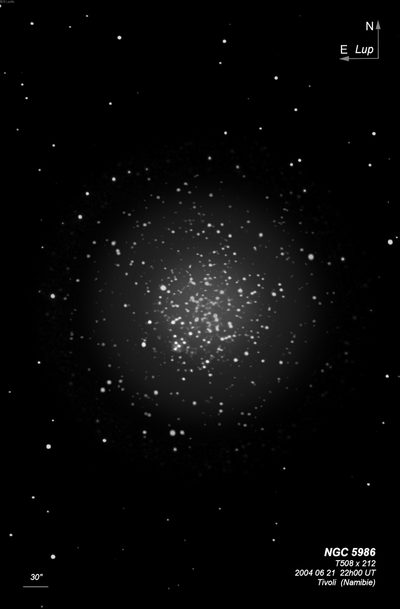
James Dunlop discovered NGC 5986 = D 552 = h3611 on 10 May 1826 and described "a beautiful round pretty bright nebula, about 2' diameter, pretty well defined." Dunlop reported 3 observations and his published position was 5' too far north. John Herschel made 2 observations and first recorded on 28 Jun 1834 "globular, fine object, pgbM, diam 15', composed to distinct stars 13..15th mag, one star 10th mag is eccentric, and 3 of 13th mag in centre nearly." Christian Peters independently found the cluster around 1849 and reported it as new in 1856 (AJ 2).
200/250mm - 8" (6/27/81): fairly bright, moderately large, very grainy. A few stars are visible at the NE edge. Includes one bright straggler.
300/350mm - 13.1" (6/19/82): only a few stars are resolved primarily in the NE region. One brighter star is detached off the east side.
400/500mm - 17.5" (6/3/00): this fairly bright globular has a 4' halo surrounding a bright 2' core. At 500x, about 30 stars were resolved including a fairly prominent string along the north side (running ~E-W) and many faint stars in the halo and at the edge of the core. A brighter mag 12.5 star is off the following end.
Notes by Steve Gottlieb
NGC 5834
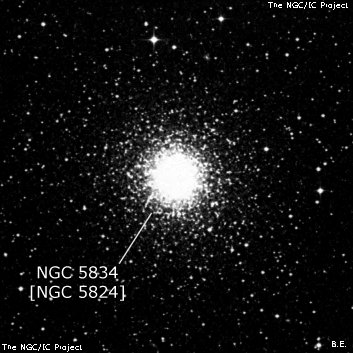
200/250mm - 8" (6/27/81): small, bright core.
400/500mm - 17.5" (6/3/00): moderately bright globular, small, ~2.5' diameter. It contained a sharply concentrated 1' core that was very prominent, surrounded by a symmetric 2.5' halo. I didn't see any definite resolution at 500x although the halo was mottled and one or two "sparkles" were glimpsed (one at the SE end of halo).
Notes by Steve Gottlieb
NGC 5882
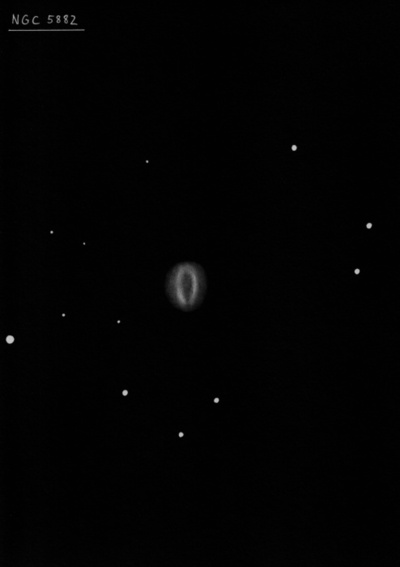
300/350mm - 13.1" (3/17/86): very small round disc visible at 80x, estimate V = 10.0. Good contrast gain with an OIII filter. A prominent small disc was visible at 166x with a mag 12 star 4.4' NE. Located 10.8' WNW of mag 7.4 SAO 225623. This planetary is very far south for viewing from my location in Northern California!
400/500mm - 18" (7/8/02 - Magellan Observatory, Australia): at 171x and UHC filter, this small planetary appeared as a very bright (V = 9.5), very high surface brightness round disc, ~12" diameter with a bluish color. At 228x there was an impression of a thin outer shell increasing the size to ~16" diameter.
Notes by Steve Gottlieb
NGC 5749
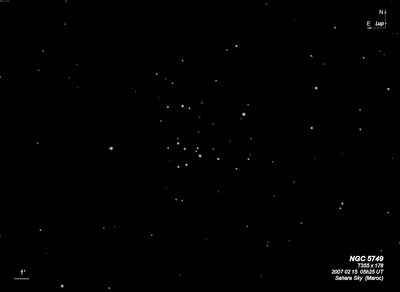
James Dunlop discovered NGC 5749 = D 206 = h3580 on 7 May 1826 and described "a group of 8 or 10 pretty bright small stars, in the form of a letter Y, about 5' long, parallel to the equator, with small stars in it resembling faint nebula." His position was off by ~8'. JH made the single observation "cluster VII class; p rich, loose, irregular figure, 8', stars 10 and 11th mag."
400/500mm - 18" (7/5/05 - Magellan Observatory, Australia): With a 27 Panoptic (76x), a group of three dozen stars are scattered in an irregular 8' region. The cluster includes a number of 12th magnitude stars with a mag 9.5 star at the NW edge. At 228x, up to 60 stars within this group were counted. There are no rich subgroups but the most distinctive group is a V-shaped or "wishbone" asterism of mag 11 stars with the prongs opening to the east. Eight of the stars are grouped into wide pairs of 30" to 40" separation. A mag 9.7 yellow star lies ~6' E of the cluster.
Notes by Steve Gottlieb
NGC 5643
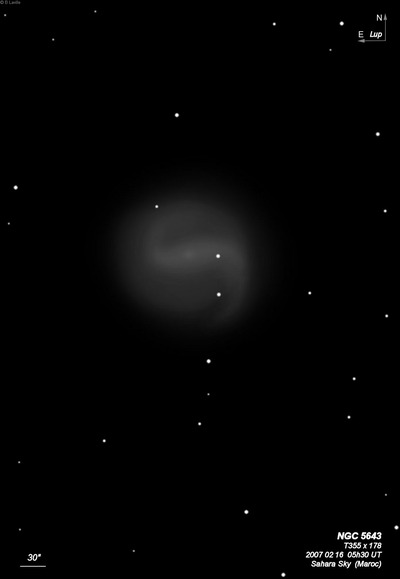
James Dunlop probably discovered NGC 5643 = D 469 = h3572 on 1 Jun 1834 and recorded "an exceedingly faint, extended nebula, about 10' long; rather ill-defined." His position is 7' due east of the galaxy. John Herschel first observed the galaxy on 1 Jun 1834 and logged "pB, L, vgbM, 2', resolvable, or with stars." Two nights later he noted "pF, L, R, vglbM; has many stars intermixed."
300/350mm - 13.1" (4/10/86): faint, diffuse, fairly small. Two stars are superimposed on the south and SW side.
400/500mm - 18" (7/5/05 - Magellan Observatory, Australia): fascinating glimpses of structure at 228x! This galaxy was fairly bright and large, round, ~3.5' diameter. The surface brightness was clearly patchy in the halo due to the strong impression of clockwise spiral structure but there was only a broad, weak concentration in the center, except for a sharply concentrated, bright 15" nucleus. A broad spiral arm is attached on the east side of the galaxy and shoots sharply to the north. There was an impression of another spiral arm attached on the west side of the galaxy. It appeared to sweep towards the south in a clockwise orientation, though this structure was not as well defined. A string of five stars angling SSE to NNW appear to puncture the galaxy on the south side with the northern two stars superimposed on the west side of the galaxy. The last star in the chain is just west of the nucleus. Located in a star field densely peppered with stars.
600/800mm - 24" (4/11/08 - Magellan Observatory, Australia): at 260x I was very impressed with this large, bright barred spiral. The halo is slightly elongated, ~3.5'x3.0' and sharply concentrated with a very bright, small, core. A brighter bar oriented E-W extends through the center. A star is superimposed on this bar to the west of the core. A second superimposed star lies 35" to the south and continuing on this line is a third star just at the edge of the halo, 1.7' S of center. At the east end of the bar a slightly enhanced arc sweeps clockwise to the north and a similar enhancement on the west side sweeps to the south. The faint arc or arms wrap around 180° making a complete outer ring. The central bar and the outer ring together formed the Greek letter "Theta". NGC 5643 is situated in a fairly rich Lupus star field.
Notes by Steve Gottlieb
IC 4406
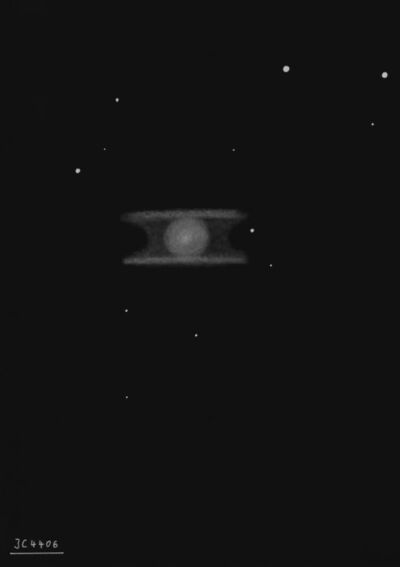
Williamina Fleming discovered IC 4406 = D.S. 403 = Fleming 94 in 1901 on a Harvard objective prism plate from Arequipa (1901HarCi..60....1P). DeLisle Stewart also found this planetary on a plate taken in 1899 at Harvard's Arequipa Station, though published in 1908. He noted "2 nebulous stars make dumb-bell, remarkable." Finally, Robert Innes independently found it a third time while observing with the 7-inch Metz refractor of the Royal Observatory at the Cape of Good Hope. He wrote, "As seen with the 7-inch on 14 August 1901 this is a fine planetary nebula, 10th magnitude, about 20" in diameter. Examined on the same night with the 18-inch telescope, it appears dumb-bell-shaped..." Perhaps surprisingly, John Herschel missed this fairly bright planetary.
300/350mm - 13.1" (2/20/04 - Costa Rica): at 140x this bright bipolar planetary appeared fairly small, 20"-25" diameter with a high surface brightness and a bluish color. The outline is unusual, appearing somewhat boxy or rectangular in appearance. A faint star is just off the west edge. At 195x there appeared to be very faint extensions ~E-W, increasing the dimensions to 2:1.
13.1" (3/17/86): fairly bright and prominent with a Daystar 300 filter although viewed at a low elevation. Fairly small, 35" diameter, smooth disc. Visually appeared almost round although photos reveal a very elongated shape. No central star seen at 214x. A mag 13.5 star is just off the west edge.
13.1" (6/18/85): viewed for 1-2 minutes as it appeared and disappeared just east of Fremont Peak from Coulter Row. Appeared fairly bright and fairly small and roundish.
400/500mm - 18" (7/5/05 - Magellan Observatory, Australia): at 228x, this is a very striking planetary with an unusual appearance. The main body is bright and boxy, roughly 25" diameter with a bluish color. A number of mag 14 stars appear to huddle around the planetary including a mag 13.5 star at the west end and some additional mag 13 stars are within 2'. Much fainter extensions or wings are just visible extending E-W from the main body with the western wing slightly more prominent (though this may be due to the superimposed star). The wings are more obvious when a UHC filter is used. At 293x, there are three collinear stars just off the west edge with the western extension encompassing the closest star. The wings increase the overall dimensions to ~60"x25".
Notes by Steve Gottlieb
NGC 5873
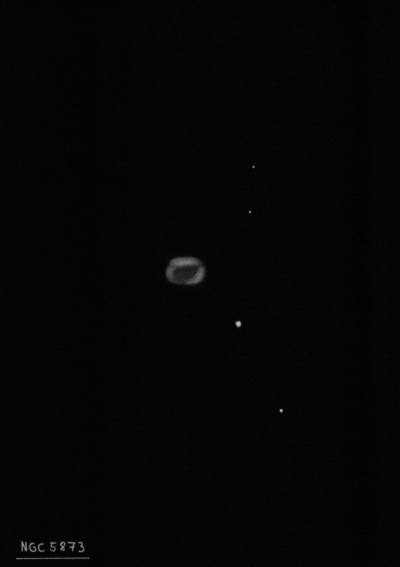
Ralph Copeland discovered NGC 5873 on 2 May 1883 near Lake Titicaca using a 6.1" refractor with a direct vision Vogel-spectroscope. The position given in Copernicus III (1884) is 8 sec of RA too far west and 2' north. This was the first deep sky object to be discovered in South America. Copeland discovered three NGCs in the Andes using this visual spectroscopy including NGC 5315, just two nights later.
300/350mm - 13.1" (3/17/86): appears stellar at 79x and quite prominent with an OIII filter. A barely non-stellar disc was seen at 166x. Forms a near equilateral triangle with fainter mag 12 stars 1.8' W and 2.1' S. Estimate mag V = 11.5.
Notes by Steve Gottlieb
NGC 5530
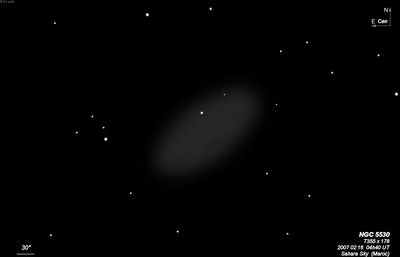
John Herschel discovered NGC 5530 = h3563 on 7 Apr 1837 and recorded "a star 12m, perfectly sharp in the center of a very dilute, very gradually fading atmosphere, pmE; 90" l, 40" br. A very remarkable specimen of its class." His position is accurate. Robert Innes described the galaxy with a 7-inch from the Cape of Good Hope as "a fine nebulous star".
300/350mm - 13.1" (4/10/86): faint, fairly small, almost round, very bright stellar nucleus (~12th mag) surrounded by a diffuse halo. Very far southern galaxy to view from Northern California.
400/500mm - 22" (6/28/06 - Hawaii): fairly faint, fairly large, elongated 5:2 NW-SE, 3.5'x1.5'. Appears as a low even surface brightness glow except for a 12th magnitude star that appears to be superimposed on the center! The galaxy seems to extend further to the NW of the star or the halo may be slightly brighter is this direction. Located 3.8' SSW of a mag 10.2 star. A small rectangular asterism of 4 mag 13-14.5 stars follows by 3'.
Notes by Steve Gottlieb
IC 4441
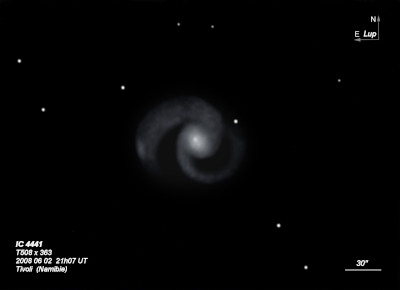
ESO 272-011 (misidentied as IC 4441 in several sources), located 17' SW, appeared faint, small, round, 20" diameter. Located 1.6' SE of mag 8.9 HD 126996. This star is at the eastern vertex of an isosceles triangle with a mag 9.4 3.3' to it NNW and a mag 11.3 star 3.3' to its W.
DeLisle Stewart found IC 4444 = D.S. 407 on a plate taken in 1899 at Harvard's Arequipa Station. He noted "vF, vS, * M, spir or ring nebula, remarks (AN. 147, 209, Sw. XI, 171, p[recedes] 0.3m, s[outh] 6')." His remark states "observed by Frost on A 6765 as bM, magn. 13." Stewart referenced Swift's XI-171 = IC 4441, discovered on 28 Mar 1897, and described as "pF; pS; R." There is nothing at Swift's position and ESO and PGC identify ESO 272-011 as IC 4441.
But Malcolm Thomson argues (and Corwin concurs) that ESO 272-011 is too faint to have been seen by Swift and it is much more likely that IC 4441 is an earlier observation of IC 4444. In addition, ESO 272-011 has a nearby 9th mag star that Swift would have almost certainly have mentioned. See Malcolm Thomson's IC identifications.
600/800mm - 25" (4/4/19 - OzSky): at 244x; very bright, fairly large, oval 5:4 or 4:3 E-W, ~1.5'x1.2'. Sharp concentration with a small, bright core and a sharp extremely bright stellar nucleus at the center. ESO 272-011 (misidentified as IC 4441 in the ESO) lies 17' SW.
Notes by Steve Gottlieb
NGC 6026
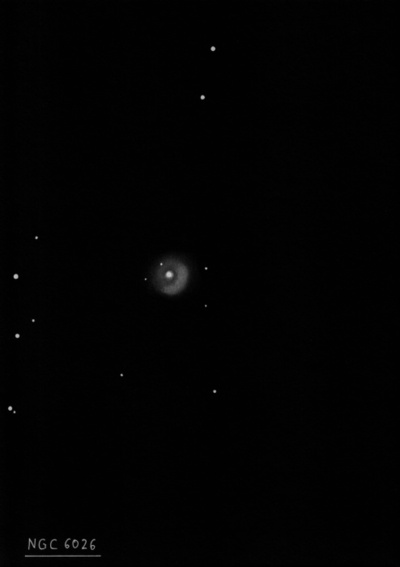
John Herschel discovered NGC 6026 = h3617 on 8 Jun 1837 and recorded "F; S; R: 15"; gpmbM. There are 3 stars forming a triangle about 60°, np the nebula." His position is at the west edge of the planetary.
NGC 6026 was misclassified as an elliptical galaxy in the 1932 Shapley-Ames catalog, with dimensions 1.0'x0.8', mag(p) = 12.5. In the course of a photographic survey of bright southern galaxies at Mt Stromlo, de Vaucouleurs noticed the appearance suggested it might be a galactic PN. He notified Nicholas Mayall of Lick Observatory who obtained a spectrogram, which established it was a planetary nebula (announced in 1955PASP...67..418D). de Vaucouleus omitted it from the 1964 Reference Catalogue of Bright Galaxies as well as Alan Sandage in the 1981 revised S-A catalogue.
200/250mm - 8" not found.
300/350mm - 13" (7/5/83): very faint, small, round. A very faint mag 14 central star is visible. The planetary is visible with direct vision using a UHC filter. Located 7.3' NW of mag 7.6 SAO 207243.
400/500mm - 17.5" (6/30/00): at 220x this fairly faint PN appeared slightly elongated SW-NE, ~50"x35". The 14th magnitude central star is easily visible encased by an evenly lit disc. The edges of the halo appear somewhat ragged but the PN is crisp-edged at 280x using a UHC filter.
Notes by Steve Gottlieb
NGC 5593
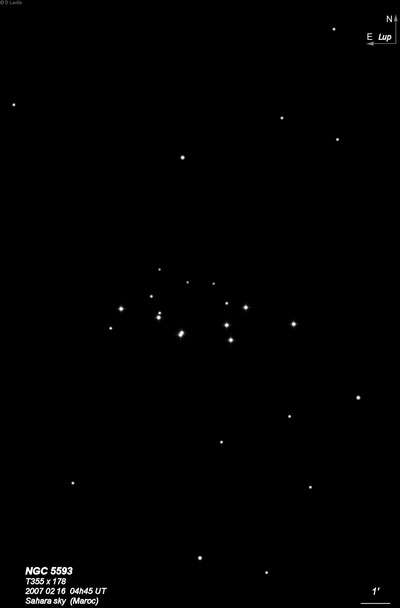
James Dunlop discovered NGC 5593 = D 350 = h3566 on 8 May 1826 and described "a curved line of small stars, south preceding a star of the 7th magnitude". Although his position is well off, the description applies though the star of 7th magnitude - not the cluster - is south-southwest.
John Herschel described NGC 5593 as "a poor, coarse, oblong cluster, which is the most condensed part of a rich region of stars 10m. Place of a double star [HJ 4675] in the following part."
400/500mm - 18" (7/5/05 - Magellan Observatory, Australia): picked up at 76x as fairly striking elongated group of stars. At 228x, this is a distinctive group of 11 brighter mag 10/11 stars including a nice pair (h 4675 = 10/11 at 8") and perhaps 30 stars total in a 7'x2.5' group that is quite elongated E-W. The cluster is well-detached in the field. In the center is a nearly 1.5' region devoid of stars which separates the cluster into two subgroups with the double star just following this vacuity. Appears fully resolved, even at low power.
Notes by Steve Gottlieb
NGC 5927
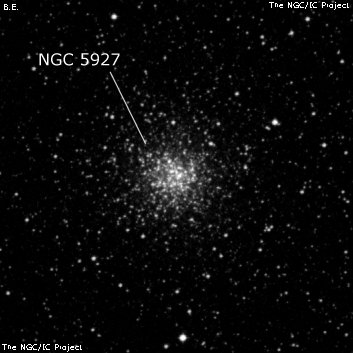
James Dunlop discovered NGC 5927 = D 389 = h3604 on 8 May 1826 and describing it (based on 8 observations) as "a very fine round pretty bright nebula, about 3' diameter, gradually brighter towards the centre, and well defined at the margin: this is resolvable. With a power of 260 it has a beautiful globular appearance. The stars are considerably scattered on the south side." John Herschel described it on 7 Jul 1834 as "globular, B, L, R, gbM, diam in RA = 16 seconds. Comes up to a bright blaze in middle. Resolved by left eye. Stars 17th mag." On a later sweep he called it "globular, pB, fine highly condensed, vgbM, 3' diameter, clearly resolved. I see all the stars (15th mag) well."
200/250mm - 8" (7/13/91 - Southern Baja): moderately bright, fairly small, 4' diameter, round, gradually increases to bright core, lively but no resolved. Fainter gc NGC 5946 is 70' E. Viewed at only 14° elevation from Baja.
400/500mm - 18" (7/4/05 - Magellan Observatory, Australia): at 128x, this fairly bright globular is fairly large, roundish, ~6' diameter. Broadly concentrated to a 3' core that brightens slightly to the center. Within the halo and scattered just outside the periphery of the ragged halo are two dozen faint stars, though it was difficult to clearly distinguish these outliers from the uniformly rich star field that surrounds the globular. At 228x, at least three dozen mag 14-15.5 stars are resolved and the core is very lively and granulated. I had the strong impression that it was on the verge of more extensive resolution. A mag 10 star lies 4.5' due south of center with a mag 11 star 3' NW. The halo extends to nearly the line connecting these two stars. NGC 5927 forms a pair with globular NGC 5946 just over a degree following within Norma.
Notes by Steve Gottlieb